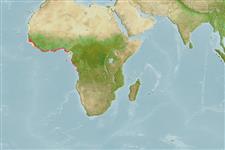Preferred temperature (Ref.
115969): 20.2 - 27.9, mean 26.4 (based on 180 cells).
Phylogenetic diversity index (Ref.
82804): PD
50 = 1.0000 [Uniqueness, from 0.5 = low to 2.0 = high].
Bayesian length-weight: a=0.00933 (0.00806 - 0.01080), b=3.05 (3.01 - 3.09), in cm Total Length, based on LWR estimates for this species (Ref.
93245).
Trophic level (Ref.
69278): 2.5 ±0.25 se; based on food items.
Daya lenting (Ref.
120179): Tinggi, Waktu penggandaan populasi minimum kurang dari 15 bulan (K=0.25-0.36; tm=1; Fec=16,000).
Prior r = 0.23, 95% CL = 0.15 - 0.34, Based on 1 full stock assessment.
Fishing Vulnerability (Ref.
59153): Low vulnerability (21 of 100).
Climate Vulnerability (Ref.
125649): High vulnerability (60 of 100).
